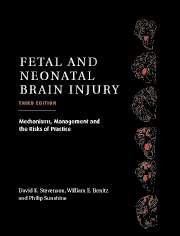Book contents
- Frontmatter
- Contents
- List of contributors
- Foreword
- Preface
- Part I Epidemiology, Pathophysiology, and Pathogenesis of Fetal and Neonatal Brain Injury
- Part II Pregnancy, Labor, and Delivery Complications Causing Brain Injury
- Part III Diagnosis of the Infant with Asphyxia
- Part IV Specific Conditions Associated with Fetal and Neonatal Brain Injury
- Part V Management of the Depressed or Neurologically Dysfunctional Neonate
- 34 Neonatal resuscitation: immediate management
- 35 Extended management
- 36 Neuroprotective mechanisms after hypoxic–ischemic injury
- 37 Neonatal seizures: an expression of fetal or neonatal brain disorders
- 38 Improving performance, reducing error, and minimizing risk in the delivery room
- 39 Nutritional support of the asphyxiated infant
- Part VI Assessing the Outcome of the Asphyxiated Infant
- Index
- Plate section
34 - Neonatal resuscitation: immediate management
from Part V - Management of the Depressed or Neurologically Dysfunctional Neonate
Published online by Cambridge University Press: 10 November 2010
- Frontmatter
- Contents
- List of contributors
- Foreword
- Preface
- Part I Epidemiology, Pathophysiology, and Pathogenesis of Fetal and Neonatal Brain Injury
- Part II Pregnancy, Labor, and Delivery Complications Causing Brain Injury
- Part III Diagnosis of the Infant with Asphyxia
- Part IV Specific Conditions Associated with Fetal and Neonatal Brain Injury
- Part V Management of the Depressed or Neurologically Dysfunctional Neonate
- 34 Neonatal resuscitation: immediate management
- 35 Extended management
- 36 Neuroprotective mechanisms after hypoxic–ischemic injury
- 37 Neonatal seizures: an expression of fetal or neonatal brain disorders
- 38 Improving performance, reducing error, and minimizing risk in the delivery room
- 39 Nutritional support of the asphyxiated infant
- Part VI Assessing the Outcome of the Asphyxiated Infant
- Index
- Plate section
Summary
Management of the infant during the immediate postpartum period is often subject to rigorous scrutiny by malpractice attorneys and their medical consultants. Although recent studies suggest that postpartum events account for only a fraction of untoward outcomes, such as cerebral palsy, mental retardation, and chronic seizure disorders (see Chapter 1), the potential for cerebral injury during the intrapartum period is real, and there is no doubt that skillful resuscitation can spare many distressed infants from exposure to potentially injurious circumstances. The approach to diagnosis and immediate management of the distressed neonate should reflect practical and well-coordinated procedures for facilitating the transition from fetal to neonatal cardiorespiratory function, as outlined in a review by Stevenson and Benitz. Although extended intensive care may not be possible in level I or even level II nurseries, the current standard of care for any hospital that provides obstetrical delivery services requires availability of personnel who can provide competent resuscitation, emergency stabilization, and preparation for transport by a highly trained neonatal team to the nearest level III facility, if necessary.
Over the past two decades a concerted effort has been made to improve the approach of providing optimal care for the newly born infant. In September 2000, the international guidelines for neonatal resuscitation were published and these comprehensively updated the recommendations that were published in 1992 and 1994 after the Fifth National Conference on Cardiopulmonary Resuscitation (CPR) and Emergency Cardiac Care (ECC).
- Type
- Chapter
- Information
- Fetal and Neonatal Brain InjuryMechanisms, Management and the Risks of Practice, pp. 673 - 691Publisher: Cambridge University PressPrint publication year: 2003



